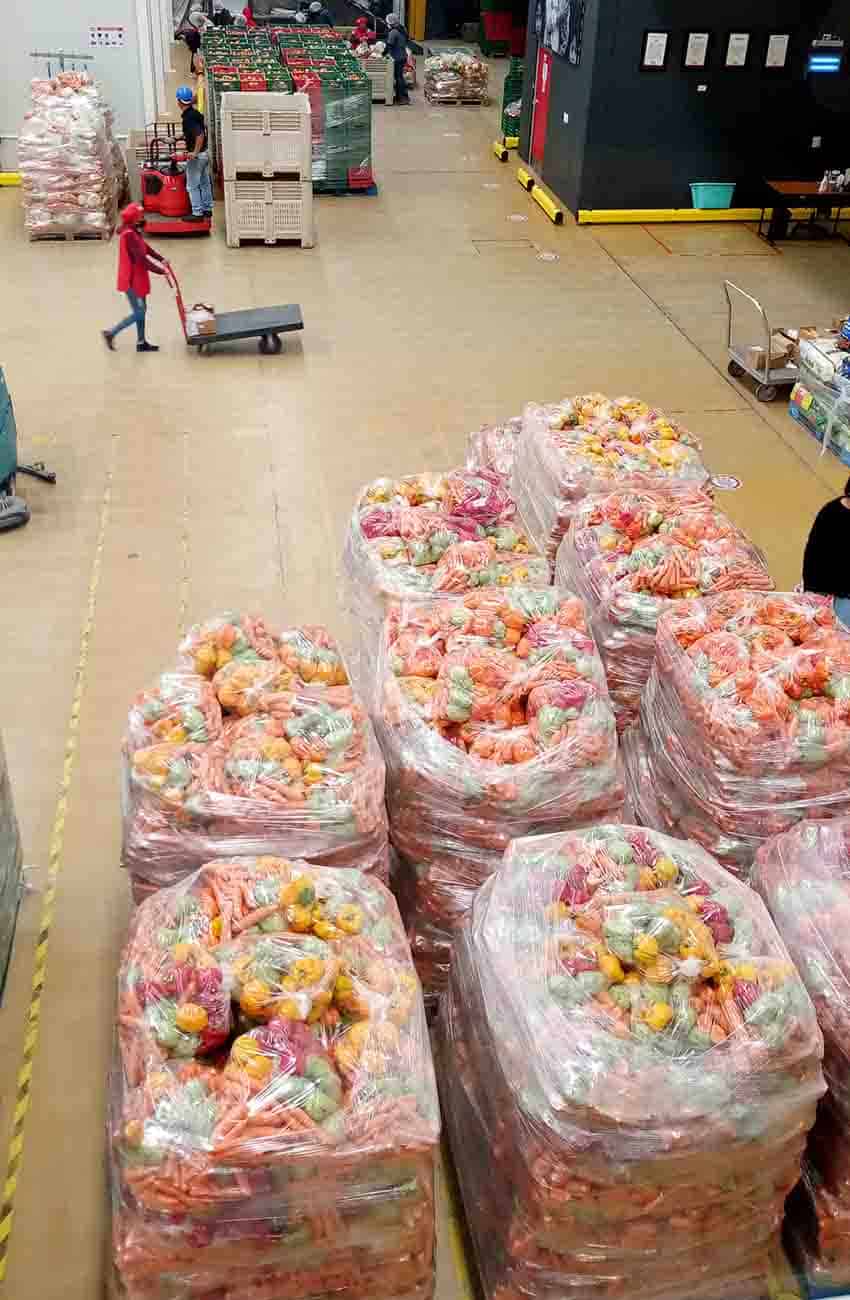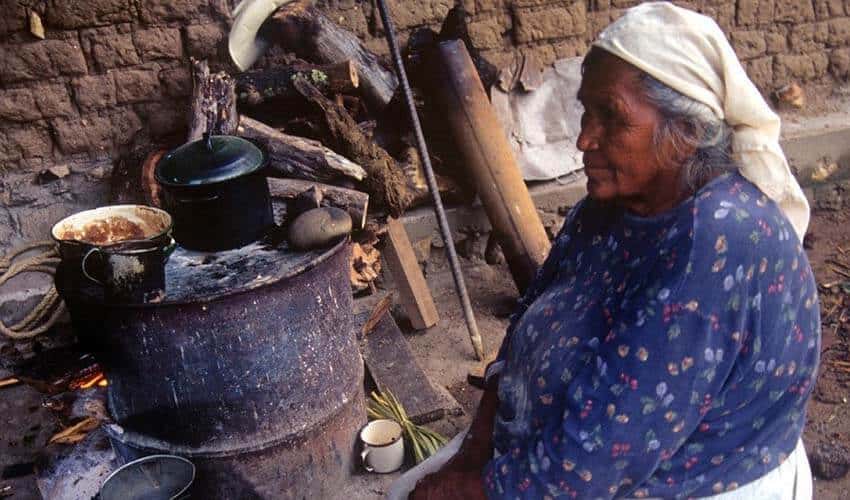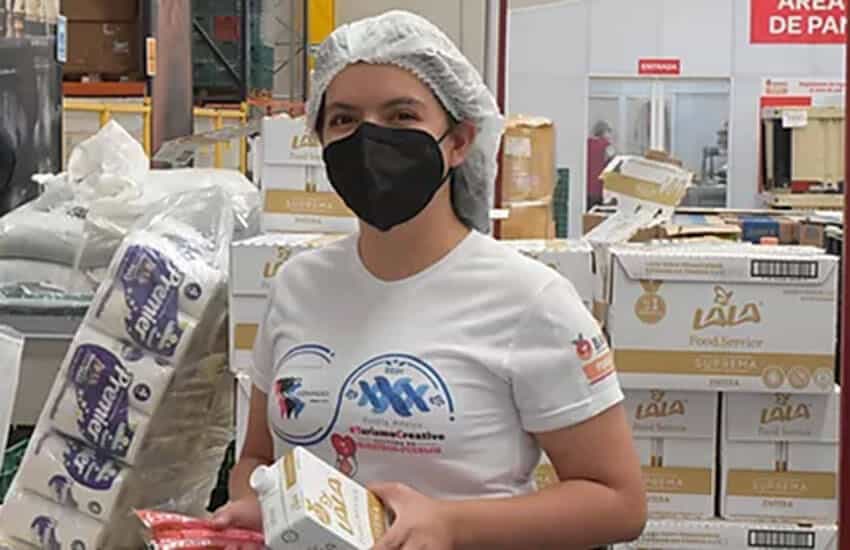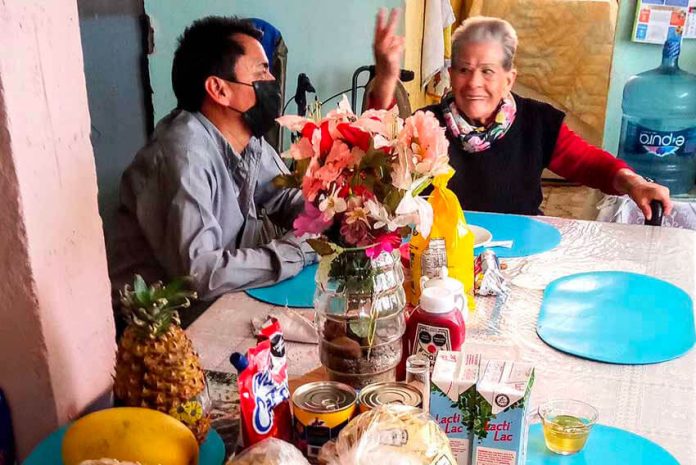Margarita Aguilar Bonilla sat alone in her modest home in Lomas de San Miguel, a largely working-class district on the eastern edge of Puebla city, when two staffers from the Puebla Food Bank appeared at her door, bearing smiles, hugs and enough food for the elderly woman and her disabled son to last a week.
The delivery was spread out over the kitchen table and onto surrounding chairs: items ranging from a large bag of red, yellow and green bell peppers, a ripe pineapple, fresh apples, carrots and chayotes to fruit juice, milk, rice and beans, pasta, bread and even pastries and cupcakes.
“This is so important to us; it’s a huge help,” Aguilar said. “And it’s a blessing because it also delivers the people who deliver the food. The attention they give to elderly people — they take care of us.”
The bounty will not only save Aguilar and her son, it will save the food itself.
All of it was “rescued” from local companies, farms, restaurants and greenhouses. Without the Puebla Food Bank, most of it would have been tossed into a landfill.

The twin plagues of food waste and starvation are of epidemic proportions in Mexico, where a staggering amount of nutritious, fresh food is thrown away each day even as millions of people go to bed hungry.
Enter the National Network of Food Banks, with 54 chapters throughout Mexico. These nonprofits, including the large, active one in Puebla, act as a bridge between food waste and feeding people in dire need.
“Every day, 50,000 tonnes of food are lost in Mexico; nearly 40% of the food produced is thrown away,” said Puebla Food Bank Director José Miguel Rojas Vértiz Bermúdez. “But even worse, on that same day, 50 million people endure hunger and malnutrition.”
Each year, some 8,000 Mexicans die of hunger, nearly one every hour.
And there’s more. The annual pollution and wasted resources from producing, processing and transporting all that food, which will never be eaten, takes a huge toll.
“It equals the amount of vehicle pollution created in Guadalajara, Monterrey and Mexico City combined,” Rojas said.
Producing the throwaway surplus also consumes 40 billion liters of water annually, “or enough to provide Mexicans potable water for nearly two and a half years,” he said.
COVID-19 has made these two problems worse, as people lost jobs and other resources. According to the National Network of Food Banks, the number of Mexicans suffering from hunger increased by 9% since the pandemic, as did the total amount of wasted food.
A recent visit to the Puebla Food Bank revealed a massive, clean, modern facility bustling with staff and volunteers who were receiving, sorting and dispatching food — not only dry and canned goods but also fresh produce that might not be ready for prime time but was still eminently edible, including slightly bruised tomatoes and carrots that were small, broken, or looked like the face of Lyndon Johnson.
The loading dock was beeping with forklifts, busy receiving, weighing and then dispatching food.
“The difference between what we take in and what we deliver in kilos is minimal,” said Procurement Coordinator Guadalupe Carmona Calva. “We try to be as efficient and transparent as possible. We get it out almost as quickly as we receive it,” she said, explaining that the shelf life was so limited.
Food rejects appropriate for animals are carefully excised from human deliveries and dispatched to the Africam safari park just outside Puebla. “Those animals need to eat too, and this way, nothing is wasted,” Carmona said.

Unspoiled food is delivered to people in the states of Puebla and neighboring Tlaxcala via climate-controlled trucks that transport them to dozens of distribution centers throughout the region or to some 120 institutions, including hospitals and orphanages.
The food bank sends 14,000 hot meals a month to eight comedores (dining rooms), runs a cafeteria for its own volunteers and staff and operates the “Ruta de Caridad” (Route of Charity), which offers food, companionship and other services to people who cannot leave their homes.
All told, that’s 1,400 tonnes of rescued food a month distributed to 150,000 people via 45,000 deliveries in 250 communities.
Alexandra Ladrón de Guevara, director of institutional outreach, is pleased with the bank’s progress but given that 1.5 million people in the State of Puebla still face food insecurity, she admits that there is a long way to go.
Still, support for the project comes from an impressive list of places — from the state and city governments (although the foundation is strictly nonpolitical); from foundations; from large companies based in Puebla, including Volkswagen and Audi; from universities and students; and from individual donors. “There are many ways to help,” she said. “Some people donate 300 pesos a month to sponsor a family, and some literally drop off rice and beans at the bank.”
Back in Lomas de San Miguel, Food Bank Route of Charity Coordinator Rodrigo Bravo Morales was chatting with Aguilar. She is frail and facing almost complete hearing loss, while her adult son has debilitating rheumatoid arthritis. Neither can work, and they depend on the weekly deliveries for survival.
Bravo is trying to find a better hearing aid for Aguilar, who worked for nine years on a noisy auto-parts assembly line before being forced to retire. Her paperwork fell through some corporate cracks, and she never collected a pension.
He has managed to procure a new toilet and bathroom sink for her home. “We have an alliance with Walmart, which donates household appliances,” he said. “They are slightly damaged, maybe a dent, but still perfectly good. So, we don’t just rescue food. We let nothing go to waste for people who need it.”
The largely homebound food bank clients on the Route of Charity receive more than just physical sustenance.
“We visit each of them once a week to check on their well-being and to see if they need anything, and we arrange for a doctor through our alliance with the (nonprofit) Dr. Simi Foundation to visit them twice a month,” Bravo said.
For some of the food bank’s clients, those who bring the weekly food deliveries are the only visitors they see. “We have become like family,” he said, adding that he sometimes arrives with flowers and a guitar to serenade Señora Aguilar.
“I always try to make them a little coffee or dessert,” Aguilar said. “They are out there running around all the time, and they deserve it.”

While Aguilar’s situation is difficult, other food bank clients have even greater challenges.
“Some people have nothing at all,” Bravo said. “They live in one-room homes without furniture and sleep on cardboard on the floor. We try to get them clothing, beds, sofas, stoves and fridges, all donated.”
In poorer communities, health problems complicate hunger exponentially. One family nearby is an older woman with an adult daughter with severe epilepsy and constant seizures.
“About two years ago, she had a seizure and fell onto a hot barbeque, burning about half of her body,” Bravo said. “The mother had to quit work to care for her daughter and then she herself fell and broke her ankle. It’s a very difficult situation. We managed to get her a wheelchair.”
Many client families have members with intellectual disabilities, paralysis, brain disease, or illnesses such as autoimmune disorders or severe GI problems.
“In many, but not all cases, they are going to need our help forever,” Carmona said. “Other clients who lost their jobs or had pay cuts will eventually be able to buy their own food again.”
And that, she said, is the overriding goal.
The food bank is currently building a large extension onto its facility, using donated sheetrock from a United States-based company. It will not only expand their capabilities for food storage, processing and delivery, it will also have dedicated spaces for training clients in food self-sufficiency and economic independence.
“Our goal is that [one day] the Food Bank will no longer exist,” Carmona said, “because people are no longer hungry.”
- If you are interested in supporting the Puebla Food Bank with a donation, you can reach them via their Spanish-language website. If you don’t understand Spanish, you can make a donation online at the website Global Giving.
